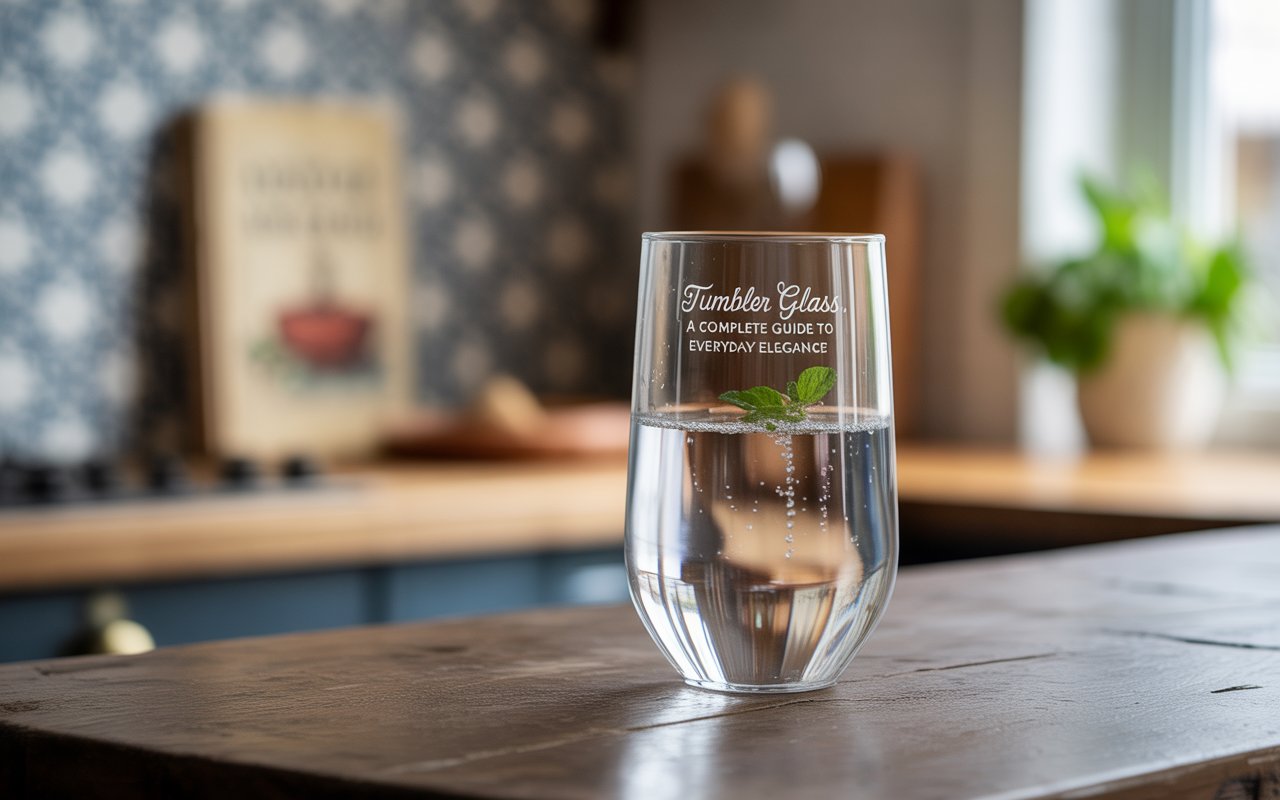When you think of a simple glass, what comes to mind? Most likely, you imagine the short, sturdy tumbler that sits in your kitchen cabinet or on a restaurant table. The tumbler glass is one of those everyday items that we often overlook, yet it carries history, versatility, and even artistry.A tumbler is more than a glass—it’s a subtle blend of function, culture, and everyday elegance.
In this article, we’ll dive deep into the world of tumbler glasses. From their history and different types to how they fit into our modern lifestyles, you’ll discover why this seemingly ordinary object deserves a closer look.
What Exactly Is a Tumbler Glass?
At its core, a tumbler is a flat-bottomed glass without a stem or handle. Unlike wine glasses or mugs, tumblers are meant to be held directly in the hand, giving them a casual, approachable feel. Their design is simple, yet functional—they don’t tip easily, they stack neatly, and they’re suitable for almost any kind of drink.
Think of tumblers as the “jeans” of drinkware: versatile, timeless, and always useful.
A Short Journey Through History
The tumbler glass has been around for centuries, with early versions traced back to ancient civilizations. People in Mesopotamia and Rome used clay or metal vessels that closely resembled today’s tumblers. By the Middle Ages, glassmaking improved, and the tumbler became a common household item across Europe.
Interestingly, the word “tumbler” comes from the old English term for cups that tended to roll over if set down. To fix this, glassmakers created flat-bottomed designs, giving us the stable tumbler we use today.
Everyday Uses of Tumbler Glasses

Why are tumblers so popular? The answer lies in their incredible versatility. These are some of the ways tumblers seamlessly fit into everyday life:
-
Water and juice: The go-to choice for breakfast tables and casual dining.
-
Cocktails and spirits: Short tumblers, often called “rocks glasses,” are perfect for whiskey or mixed drinks.
-
Soft drinks and iced beverages: Their wide mouth makes them ideal for clinking ice cubes.
-
Desserts and snacks: Believe it or not, tumblers are often repurposed to serve layered desserts or even small appetizers.
In short, a tumbler can fit almost any occasion—from a quick sip of water to a classy cocktail party.
Different Types of Tumbler Glasses
Not all tumblers are the same. Over the years, they’ve evolved into many variations. Let’s explore a few popular types:
Highball Tumbler
Tall and slim, highball tumblers are perfect for mixed drinks like gin and tonic, mojitos, or simple soda with ice.
Lowball Tumbler
Also known as an “old-fashioned” glass, this short, sturdy design is a favorite for whiskey on the rocks.
Stackable Tumbler
Found in diners, cafeterias, and family homes, these are designed for easy storage.
Crystal Tumbler
Elegant, often with intricate designs, crystal tumblers are a symbol of luxury. They’re often reserved for special occasions or formal settings.
Plastic or Acrylic Tumblers
Perfect for outdoor gatherings, picnics, or kids. They’re durable, lightweight, and less prone to breaking.
Materials: Beyond Just Glass
While we often imagine tumblers made of clear glass, they come in a wide range of materials:
-
Glass: Classic, transparent, and timeless.
-
Crystal: Adds sparkle and elegance.
-
Plastic: Practical and affordable.
-
Stainless steel: Keeps drinks colder for longer, great for travel.
-
Bamboo or eco-friendly composites: Gaining popularity for their sustainable appeal.
Each material has its pros and cons, but together they show just how adaptable the tumbler is.
Why Tumbler Glasses Are a Household Essential

If you open any kitchen cupboard, chances are you’ll find at least a few tumblers. But why are they so essential?
-
Durability: Their sturdy design makes them less likely to break compared to delicate stemware.
-
Functionality: One glass works for multiple drinks.
-
Storage-friendly: Easy to stack and store.
-
Timelessness: Their simple design never goes out of style.
It’s like having a reliable pair of sneakers—you can use them daily without a second thought.
Tumbler Glass in Fine Dining and Bars
Walk into a fancy restaurant or cocktail bar, and you’ll notice tumblers taking center stage. Bartenders rely on them for signature drinks because of their perfect balance of size and stability. In fine dining, crystal tumblers often double as conversation starters, their sparkle adding an extra layer of charm to the dining experience.
Cultural Significance Around the World
Different cultures have unique relationships with tumbler glasses:
-
In Japan: sleek and minimalist tumblers are cherished for serving both sake and fine whiskey.
-
In India: Stainless steel tumblers are common in households for water and milk.
-
In Western countries: Glass tumblers dominate dinner tables and cocktail settings.
The tumbler has traveled across borders, adapting to traditions while keeping its universal identity.
Caring for Your Tumblers

Like any household item, tumblers need a little care to last long. Here are some tips:
-
Hand-wash crystal: Preserve shine by avoiding dishwashers.
-
Avoid sudden temperature changes: Prevent cracking in glass tumblers.
-
Store carefully: Stack sturdily but don’t overcrowd.
-
Use polishing cloths: Keep crystal tumblers sparkling.
Taking care of your tumblers not only extends their life but also keeps every drink enjoyable.
Choosing the Right Tumbler for You
Not all tumblers will suit your lifestyle. Here’s how to pick the right one:
-
For daily use: Go for sturdy glass or stainless steel.
-
For kids or outdoors: Opt for plastic or acrylic.
-
For special occasions: Crystal adds elegance.
-
For cocktails: Lowball or highball glasses are best.
Choosing the right tumbler is like picking the perfect outfit—it sets the tone for the occasion.
The Future of Tumbler Glass Design
Designers are experimenting with tumbler glasses in exciting ways. Some brands are incorporating double-wall insulation, eco-friendly materials, and even smart technology that tracks your water intake. The tumbler, it seems, is evolving with us in this modern age.
Why We Love Tumbler Glasses
At the end of the day, tumblers are more than vessels for drinks. They represent simplicity, versatility, and everyday elegance. Whether it’s a casual family dinner, a late-night cocktail, or a celebratory toast, the tumbler quietly plays its part in making the moment complete.
FAQs About Tumbler Glasses
1. What is the difference between a tumbler and a wine glass?
A tumbler has a flat bottom with no stem or handle, while a wine glass typically has a stem to hold and a bowl-shaped top.
2. Can tumblers be used for hot drinks?
Yes, but it depends on the material. Glass and stainless steel tumblers handle hot drinks well, while thin crystal may not be suitable.
3. Are crystal tumblers safe for everyday use?
They are safe but delicate. Many people reserve them for special occasions to avoid accidental chips or breaks.
4. How do I remove stains from glass tumblers?
Soak them in a mixture of vinegar and warm water, then gently scrub with a soft sponge.
5. What size tumbler is best for cocktails?
An 8–10 oz lowball glass is perfect for whiskey or short cocktails, whereas a 10–14 oz highball shines with mixed drinks.
Conclusion
The tumbler glass may seem ordinary, but its story is anything but dull. It’s a piece of history, culture, and design that has found a place in every household. From crystal showpieces to plastic outdoor essentials, tumblers adapt to our needs while maintaining their timeless charm.
Next time you pick up a tumbler, take a moment to appreciate its journey—from ancient times to your kitchen table.













